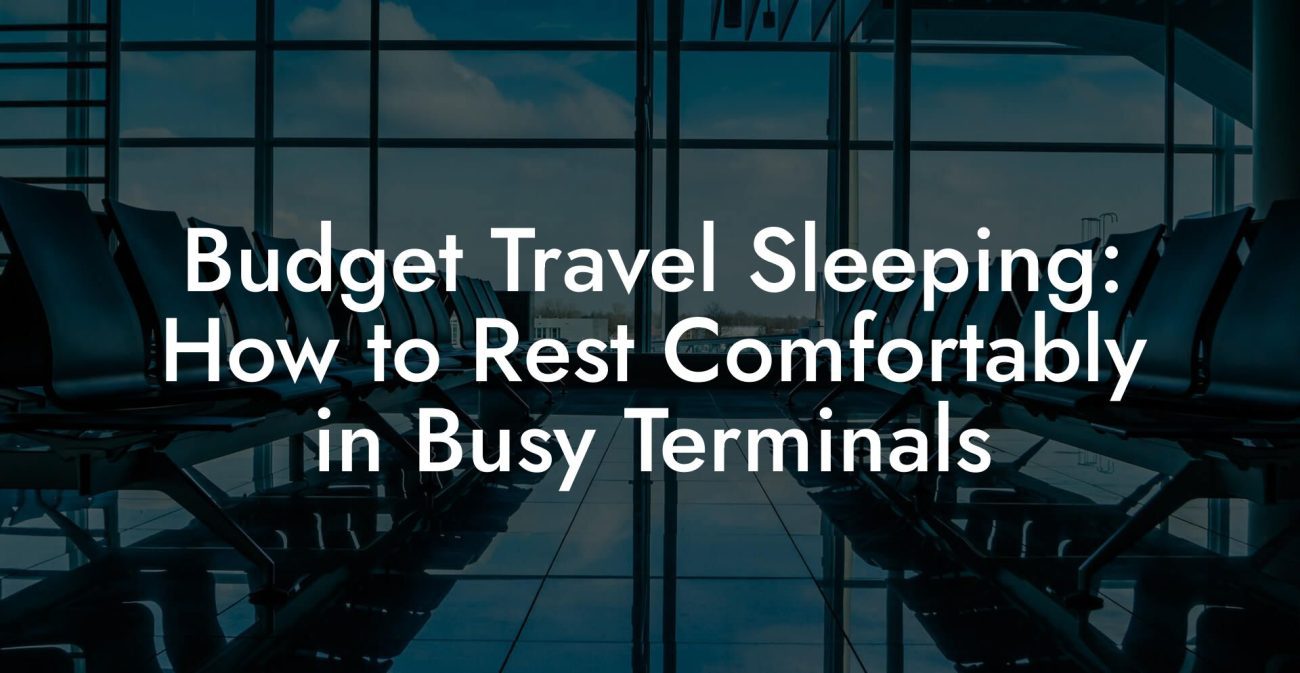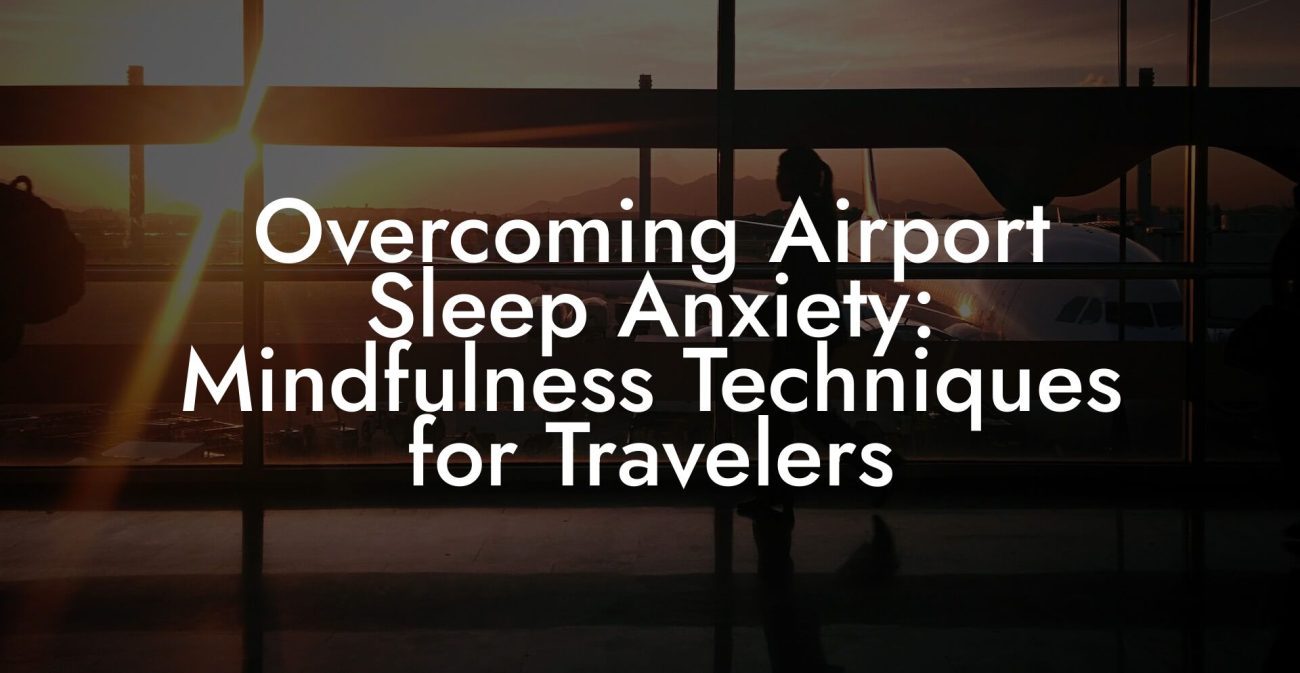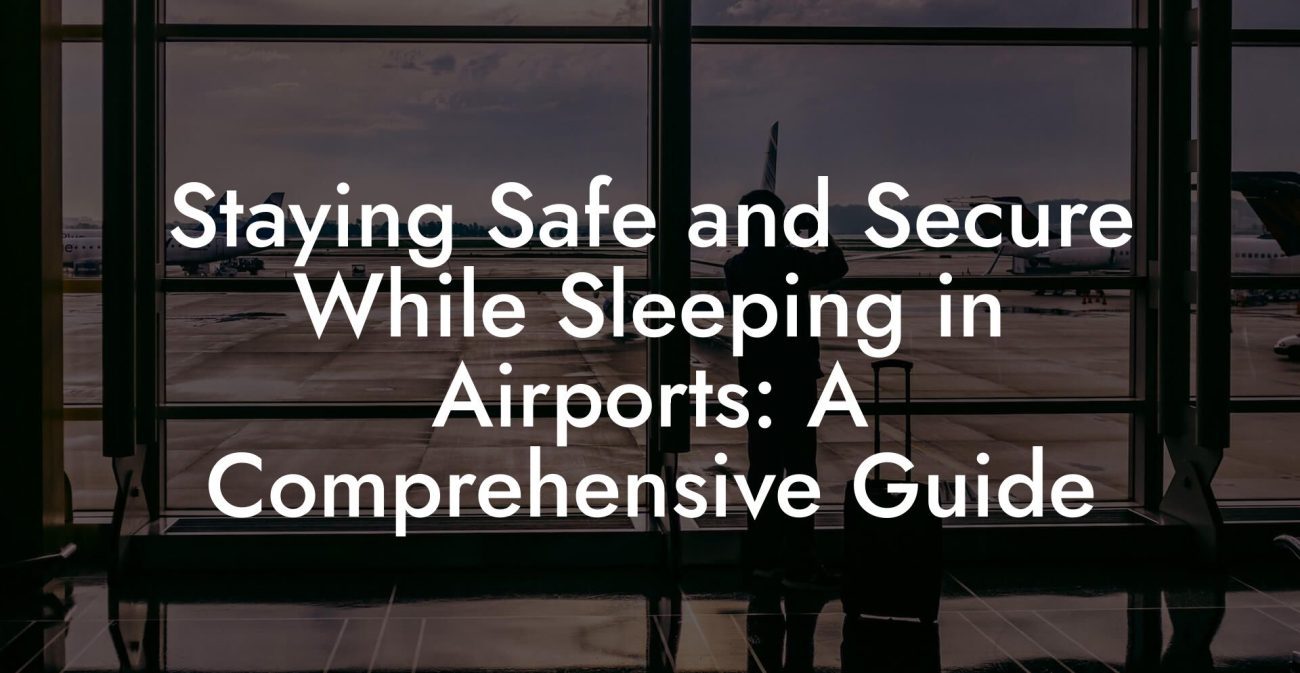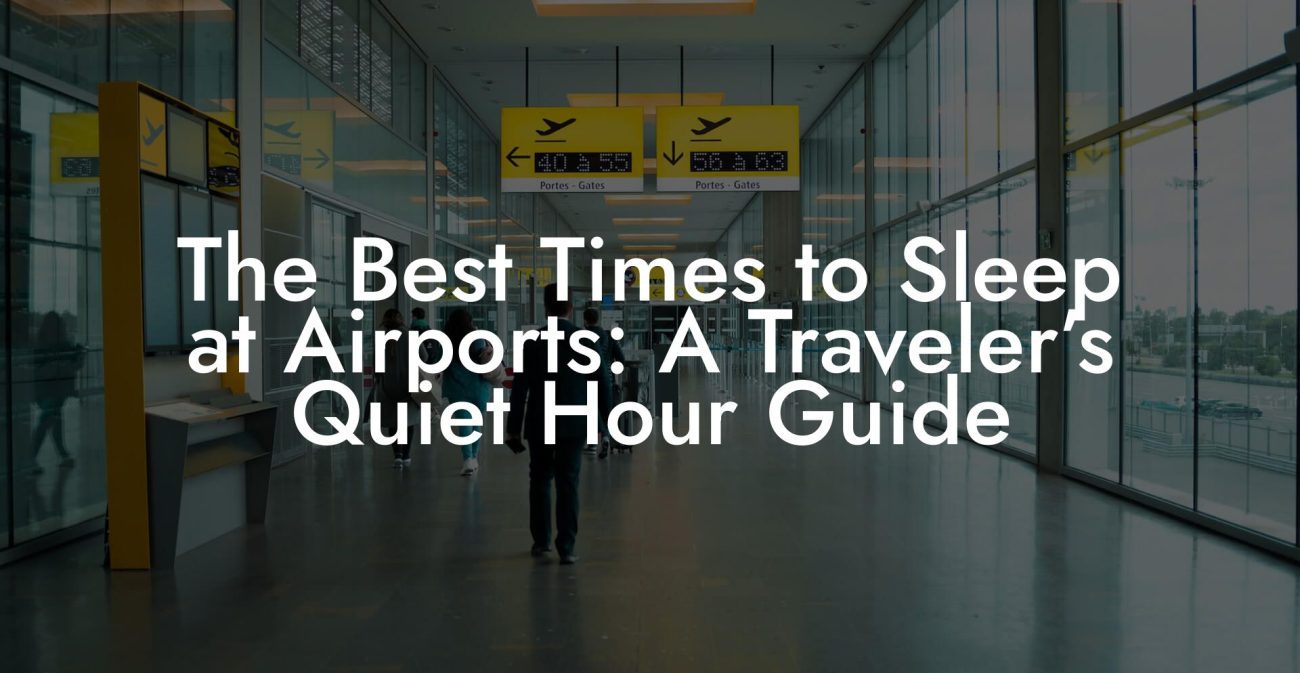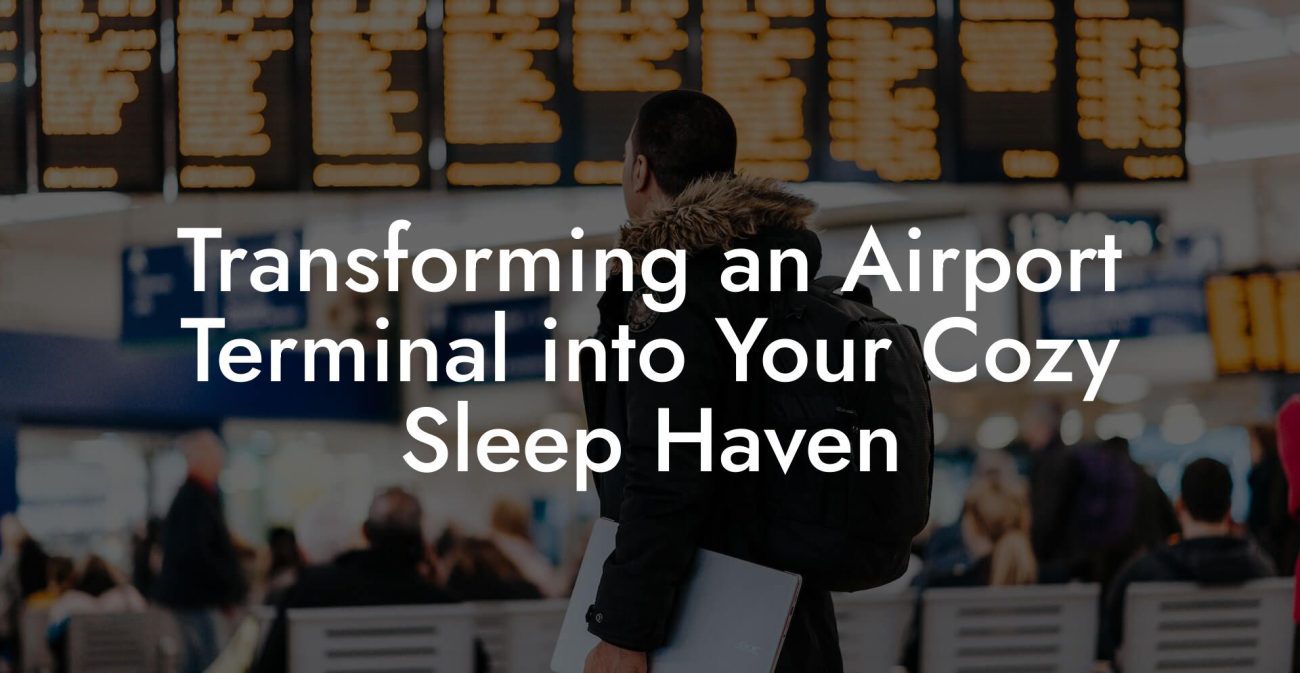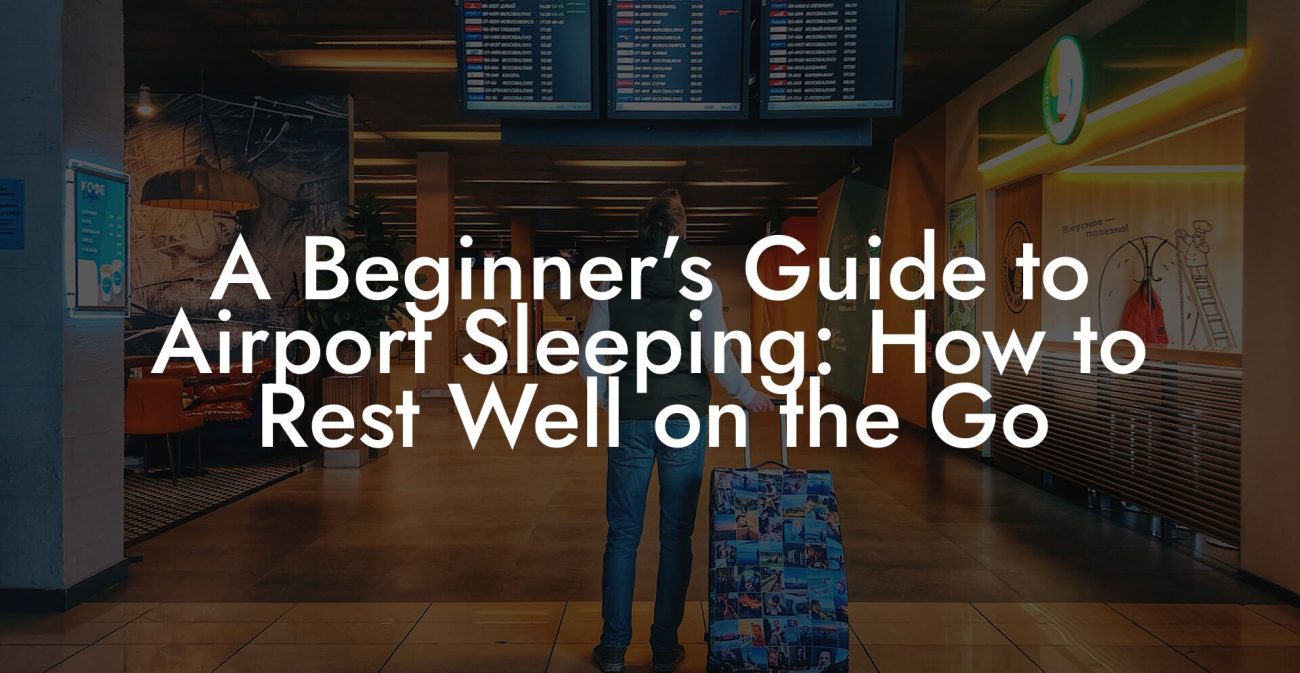Ever found yourself sprawled awkwardly on a cold, hard airport bench, scrolling through your phone as you wonder how a place built for transit turned into your impromptu hotel? If you’ve ever ventured into the wild world of airport sleeping, you know that catching some shut-eye in a terminal is both an art and a survival skill. In this expert guide, we’re diving deep into the ultimate do’s and don’ts of sleeping in airports—packed with savvy tips, hilarious mishaps, and practical advice that’s perfect whether you’re a millennial on a budget or a Gen-Z nomad chasing your next adventure.
Quick Links to Useful Sections
- Sleeping in Airports: The Unexpected Side of Travel
- Understanding the Airport Sleep Phenomenon
- The Do’s for Sleeping in Airports
- Do Scout Out Your Sleeping Spot in Advance
- Do Pack a Travel Pillow and a Light Blanket
- Do Invest in a Good Pair of Noise-Cancelling Headphones
- Do Keep Your Essentials Close
- Do Dress Comfortably (But Keep It Stylish)
- The Don’ts for Sleeping in Airports
- Don’t Assume Every Spot Is Safe
- Don’t Flash Your Valuables
- Don’t Depend Solely on Your Phone as an Alarm
- Don’t Overpack Your Carry-On
- Don’t Get Too Cozy with Strangers
- Expert Tips for a Quality Airport Nap
- Tip 1: Timing Is Everything
- Tip 2: Utilize Airport Sleeping Pods and Lounges
- Tip 3: Stay Informed with Flight Alerts
- Tip 4: Hydrate Strategically
- Tip 5: Master the Art of Seamless Camouflage
- Gear and Gadgets: Must-Haves for Airport Sleepers
- Travel Pillow and Blanket Combo
- Noise-Cancelling Headphones / Earplugs
- Portable Charger and Power Bank
- Compression Socks
- Multi-Functional Travel Organizer
- The Rise of Airport Sleeping Pods and Lounges
- Sleep Hygiene and Health Considerations
- Maintain a Regular Sleep Schedule
- Mind Your Caffeine Intake
- Stretch and Move Around
- Manage Light Exposure
- Making the Most of Your Layover
- Explore Nearby Attractions (If Time Permits)
- Utilize Airport Amenities
- Plan Short Activity Bursts
- Resources and Community Support: Your Next Steps
- FAQs: The Do’s and Don’ts of Airport Sleeping
- Your Ultimate Guide to Airport Sleep Mastery
Sleeping in Airports: The Unexpected Side of Travel
Airports are like a microcosm of life: bustling energy, quirky characters, and sometimes, an opportunity to catch a few winks before your next flight. But while some travelers can afford a snazzy airport lounge, many of us know that the reality often involves ghost-like quiet corners, overpriced snacks, and the constant threat of being rudely awakened by flight announcements.
This guide is here to help you master the delicate balance between comfort and caution. Whether you’re braving a long layover, enduring an unexpected delay, or simply optimizing your travel budget, our expert advice will turn you from a sleep-deprived wanderer into a savvy airport sleeper.
With a humorous twist and down-to-earth insight, read on for the definitive list of do’s and don’ts when it comes to sleeping in airports and utilizing airport sleeping pods. Get ready to conquer the terminal—and your travel fatigue—with confidence!
Understanding the Airport Sleep Phenomenon
Airports have morphed into unexpected sanctuaries for tired travelers around the globe. With unpredictable flight delays, early morning departures, and last-minute cancellations, the airport sleep culture has evolved as a viable, albeit quirky, solution for rest on the go.
For many, the experience of sleeping in an airport is less about luxury and more about necessity. And while it might not come with fluffy pillows or complimentary room service, it undeniably requires a blend of practical preparation and street-smart tactics. The term “airport sleep” now conjures images of travel hacks ranging from finding the coziest chair in the terminal to scouting out hidden sleeping pods that promise a few extra Zs.
In this section, we’ll explore why sleeping in airports isn’t just a last-resort option—it’s a skill worth mastering for any savvy traveler looking to maximize every minute of their journey.
The Do’s for Sleeping in Airports
When it comes to catching your much-needed nap amidst the roar of intercoms and clattering suitcases, preparation is everything. Here are the top do’s to ensure your airport sleep experience is as comfortable and secure as possible.
Do Scout Out Your Sleeping Spot in Advance
If your layover is long enough to consider a snooze, spend some time researching the airport layout before you arrive. Look for quiet zones, designated rest areas, or even specialized sleep pods. Many modern airports now incorporate comfortable seating and sleeping zones designed with the weary traveler in mind.
Apps and online travel forums are your best friends when finding those hidden gems where fellow jet-setters have discovered restful havens.
Do Pack a Travel Pillow and a Light Blanket
While some airports may offer lounge areas, most terminals leave you to fend for your own comfort. A compact travel pillow and a lightweight blanket can be your ticket to a decent nap. Not only do these items create an instant cocoon of comfort, but they also help isolate you from the busy environment around you.
Do Invest in a Good Pair of Noise-Cancelling Headphones
The constant hum of airport chatter, rolling suitcases, and PA system announcements can turn your sleep into a symphony of disturbances. Noise-cancelling headphones or earplugs are essential tools for any airport sleeper aiming to shut out the chaos.
Do Keep Your Essentials Close
For safety and ease, have your phone, wallet, and travel documents within arm’s reach. A small travel pouch can be secured around your waist or tucked inside your carry-on bag. This way, you’re not only organized but also prepared in case of any unexpected wake-up calls.
Do Dress Comfortably (But Keep It Stylish)
Just because you’re sleeping in an airport doesn’t mean you have to sacrifice style. Layering is key—opt for comfortable clothing that can double as a fashionable travel outfit. Plus, those extra layers might come in handy if the terminal suddenly turns into a chilly waiting room.
These do’s are your first steps toward transforming an awkward airport bench into a sanctuary of rest.
The Don’ts for Sleeping in Airports
Sometimes, knowing what not to do is just as important as knowing what to do. Avoid these common pitfalls to keep your airport slumber safe and pleasant.
Don’t Assume Every Spot Is Safe
While many airports offer public seating free from danger, not every corner is created equal. Avoid isolated areas if you’re traveling alone, and always be aware of your surroundings. Trust your gut—if a spot feels too secluded or sketchy, it probably is.
Don’t Flash Your Valuables
It’s tempting to pull out your latest tech or snazzy accessories, but doing so in a crowd of tired, distracted travelers is a no-go. Keep your valuables hidden and be discreet about your gadgets. A low-profile bag for your essentials can be the difference between a peaceful nap and an unwanted encounter with a pickpocket.
Don’t Depend Solely on Your Phone as an Alarm
Airport Wi-Fi can be as unpredictable as your flight times. Invest in a travel alarm clock or a power bank that ensures your devices are always charged. Missing an important boarding call because your phone died or was on Do Not Disturb mode is bound to ruin the next leg of your journey.
Don’t Overpack Your Carry-On
In a bid to be fully prepared, you might be tempted to bring everything but the kitchen sink. However, a cluttered bag only makes it harder to keep track of your essentials. Keep it streamlined and pack only what you truly need to ensure ease of movement and vigilance.
Don’t Get Too Cozy with Strangers
While camaraderie among travelers is great, remember that not everyone in the terminal is a friend. Respect personal space, and be cautious about sharing your sleeping quarters or personal belongings with strangers. A friendly nod might be in order, but guard your privacy like it’s your last bag of chips.
Avoiding these don’ts ensures that your airport sleep is not only restful but also safe and hassle-free.
Expert Tips for a Quality Airport Nap
Sleeping in airports isn’t just a haphazard doze—it can be strategically planned to boost energy levels and even spark creativity. Here are some additional expert tips to elevate your airport nap game.
Tip 1: Timing Is Everything
Consider your flight schedule and plan your nap accordingly. A power nap of 20-30 minutes may be perfect to recharge without falling into a deep sleep cycle that leaves you groggy—or worse, missing your boarding call.
Tip 2: Utilize Airport Sleeping Pods and Lounges
Many airports now come equipped with specialized sleeping pods and lounges that offer more privacy and comfort than the traditional bench. These pods often feature adjustable lighting, ambient noise controls, and even charge your devices. If your budget allows, consider renting one for a few hours and treat yourself to a mini-retreat amid terminal chaos.
Tip 3: Stay Informed with Flight Alerts
Use a reliable flight tracker app that sends notifications about delays, boarding times, and gate changes. This way, even if you fall into a deep slumber, you can confidently rest knowing that you’ll be promptly alerted if any changes occur.
Tip 4: Hydrate Strategically
Hydration is key to avoiding that post-nap dehydration blues. However, balance is important—drink enough water to stay refreshed, but not so much that you’re running to the restroom every five minutes. Sip slowly and consider a small snack to keep your energy levels steady.
Tip 5: Master the Art of Seamless Camouflage
Blend into the busy crowd by adopting a low-key appearance. A well-fitted hoodie, a pair of sunglasses, and a discreet travel bag can help deter any unwanted attention. The less you stand out, the easier it is to claim your temporary recovery spot without drawing a crowd.
Implement these expert tips to transform your airport sleep into a rejuvenating intermission rather than just a desperate pit stop between flights.
Gear and Gadgets: Must-Haves for Airport Sleepers
The right gear can make all the difference when you’re preparing for airport sleep. Here are some must-have gadgets and travel accessories that can dramatically improve your experience:
Travel Pillow and Blanket Combo
As mentioned earlier, investing in a quality travel pillow—preferably one with memory foam—and a compact, lightweight blanket can create an instant oasis of comfort. Some models even come with built-in eye masks and adjustable neck support, so you can pretty much have a luxury hotel bed on the go.
Noise-Cancelling Headphones / Earplugs
In bustling airports, a pair of noise-cancelling headphones or a trusty set of earplugs can create a bubble of silence that’s essential for uninterrupted rest. Look for models that are specifically designed for travel, meaning they’re lightweight, durable, and offer long battery life or excellent passive noise cancellation.
Portable Charger and Power Bank
Nothing kills a sleep-deprived traveler faster than a dead phone battery, especially when you rely on flight alerts and digital itineraries. A robust portable charger or power bank ensures that your essential gadgets are juiced up and ready, whether you’re lulling yourself into a nap or catching up on your favorite podcast.
Compression Socks
Long periods of sitting can cause your legs to feel heavy and tired. Compression socks not only improve circulation but can also add an extra element of comfort as you navigate through the terminal or sneak in a quick nap at your gate.
Multi-Functional Travel Organizer
Prepare for your airport slumber by keeping all your travel essentials neatly organized. A well-designed travel organizer can hold your passport, tickets, phone, and even a small snack pack for emergencies. Staying organized means less stress, which translates to more peaceful sleep.
Equipping yourself with these travel accessories not only maximizes comfort but also helps you maintain control over your environment, ensuring that your airport sleep is as restorative as possible.
The Rise of Airport Sleeping Pods and Lounges
In recent years, airports worldwide have taken notice of the growing need for quality sleep solutions. Enter airport sleeping pods and lounges—a modern solution that caters to the weary traveler looking for a respite from the terminal chaos.
These high-tech havens come equipped with everything you need: adjustable lighting, privacy screens, soundproofing, and even options to book by the hour. While they might come at a premium compared to a traditional bench, the convenience, comfort, and sense of security they offer often justify the cost.
For Gen-Z and millennial travelers who are always on the lookout for efficiency and style, these pods represent the future of airport sleeping. Not only do they provide a dedicated space to recharge, but they also often feature additional amenities like showers, charging stations, and even mini snack bars.
As more airports roll out these sleeping pods, it’s become clear that the days of awkwardly sprawling on uncomfortable benches might soon be a relic of the past. Embrace the innovation, and if you get a chance, treat yourself to a session in one of these futuristic fad zones.
Sleep Hygiene and Health Considerations
Let’s get real—sleeping in an airport isn’t exactly your bedroom’s natural habitat. However, practicing good sleep hygiene can help mitigate some of the drawbacks of improvised sleep environments. Here’s how to ensure that even an impromptu snooze keeps you healthy and rested:
Maintain a Regular Sleep Schedule
As much as possible, try to maintain a consistent sleep rhythm. Drastic deviations can leave you feeling disoriented upon landing. If you know your travel schedule might disrupt your natural sleep cycle, consider adjusting your bedtime gradually in the days leading up to your trip.
Mind Your Caffeine Intake
A tempting cup of coffee might keep you awake enough for that boarding call, but overdoing it can seriously sabotage your sleep efforts. Balance your caffeine consumption, and opt for water or herbal teas when you’re aiming to wind down.
Stretch and Move Around
Sitting in one spot for too long, even if you’re catching a few nods, can lead to stiffness and cramps. Take short walks around the terminal or do some discreet stretching to keep your muscles from locking up. It’s a small effort that can yield big rewards in comfort and circulation.
Manage Light Exposure
Natural light can be both a friend and a foe. If you’re trying to sleep, consider using an eye mask to block out glaring terminal lights. Conversely, if you need to wake up and feel alert for your flight, a bit of natural light can help reset your internal clock.
By integrating these sleep hygiene tips into your airport slumber strategy, you can enhance both the quality and the restorative power of those fleeting moments of sleep.
Making the Most of Your Layover
In many ways, a long layover is an unplanned mini-vacation—a chance to catch up on rest, explore a new city, or simply enjoy some downtime. Here are some additional strategies to maximize your layover, ensuring you leave the airport feeling refreshed rather than run-down.
Explore Nearby Attractions (If Time Permits)
Sometimes, the best way to combat the monotony of the airport is to step outside. Many major airports are located near interesting landmarks, museums, or parks. A quick trip outside might not only give you a dose of fresh air but could also add a memorable chapter to your travel story.
Utilize Airport Amenities
Modern airports aren’t just about check-ins and queues; many offer a host of amenities that can improve your layover experience. Look for art installations, quiet rooms, or even in-terminal spas. These facilities are designed for stressed out travelers needing a soaking in relaxation before they take off again.
Plan Short Activity Bursts
Rather than sitting still for hours on end, plan short bursts of activity. This might include a brisk walk through the terminal, a few minutes of meditation in a designated quiet zone, or even a power yoga session in the lounge. Not only does this help pass the time, but it also keeps your energy up.
These proactive steps can help transform a dreaded layover into a delightful interlude—an opportunity to balance work, rest, and play amid your travels.
Resources and Community Support: Your Next Steps
Ready to turn your next airport stop into a haven of rest and rejuvenation? The travel community is brimming with resources, apps, and forums where seasoned travelers share their own hacks on airport sleep. Join online groups, check out YouTube reviews of sleeping pods, and explore the latest travel apps that track airport amenities.
Numerous travel blogs and social media accounts specialize in airport life hacks—from budget travel communities on Reddit to detailed Instagram accounts chronicling the best airport lounges. Tap into these networks for the latest updates, user reviews, and spot-on recommendations.
Remember, every airport is different, and your ideal sleeping strategy might require a bit of trial and error. Use community insights to craft a personalized game plan that fits your travel style, ensuring that whether you’re a frequent flyer or a once-in-a-while adventurer, you always have a nod-off formula that works.
The world of airport rest is evolving fast—embrace the continuous stream of new tips, gadgets, and travel-friendly hacks that keep your sleeping on the run as effective as it is comfortable.
FAQs: The Do’s and Don’ts of Airport Sleeping
Still have questions buzzing like overhead announcements? Here are some frequently asked questions to clear the air on everything airport sleeping.
1. Is it safe to sleep in airports?
Yes, most airports are designed with safety in mind and have visible security measures. However, always choose well-lit, populated areas, and keep your belongings secure.
2. What items should I always pack for a quick airport nap?
Essential items include a travel pillow, eye mask, lightweight blanket, noise-cancelling headphones or earplugs, and a portable charger. These items collectively help create a comfortable and secure sleep environment.
3. How can sleeping pods improve my airport rest?
Sleeping pods offer privacy, adjustable comfort features, reduced noise, and sometimes even charging stations. They provide a more hotel-like experience compared to traditional seating areas.
4. What precautions should I take with my valuables?
Keep your valuables close to you, ideally in a secure travel pouch or locked compartment. Avoid displaying expensive gadgets publicly, and be vigilant about your surroundings.
5. Can I catch enough sleep to recover from jet lag in an airport?
While an airport nap may not completely ward off jet lag, a short power nap can help boost your alertness. Combine quality naps with proper hydration and light exposure for better results.
6. How do I select the best sleeping spot in a busy terminal?
Look for designated rest zones, quiet corners away from high traffic, and consider seating arrangements that allow for a bit of privacy—even if it means setting up a small travel nest with your accessories.
7. Are there any travel apps that help locate sleeping pods?
Yes, several travel apps and airport-specific guides list amenities including sleeping pods, lounge amenities, and quiet zones. A quick search on your app store should point you in the right direction.
8. How do airport sleeping tips differ for solo travelers versus groups?
Solo travelers may have more options with secluded areas and flexibility, whereas groups might need to coordinate to find space that accommodates everyone while ensuring privacy and comfort.
9. Can I share sleep space with another traveler?
While it might be tempting, especially if you’re traveling with a friend, it’s best to maintain personal space unless you have the assurance of safety and trust. Overcrowding can lead to discomfort and potential security issues.
10. Where can I find additional tips on maximizing airport sleep?
Check out travel blogs, YouTube channels specializing in travel hacks, or communities on social media platforms. The airport traveler community is always sharing the latest insights and recommendations.
Your Ultimate Guide to Airport Sleep Mastery
From learning which terminal corners double as hidden nap zones to discovering the magic of airport sleeping pods, you’re now armed with expert insights and practical tips for turning your airport stay into a well-crafted sleep adventure.
The world of airport sleeping is as unpredictable as life itself, but with the right tactics, a bit of planning, and a dash of humor, you can transform even the busiest terminal into your personal relaxation hub. Embrace these do’s and don’ts, adapt them to your own travel style, and let every layover become an opportunity to refresh and recharge.
As you embark on your next journey, remember that mastering airport sleep isn’t just about catching z’s—it’s about creating a travel experience that’s smart, safe, and surprisingly enjoyable. Whether you’re on a tight budget or simply seeking some extra R&R between flights, these tips are your passport to a more restful travel lifestyle.
So, go ahead and book that long layover with confidence. With these strategies at your fingertips, you’re well on your way to becoming an airport sleep aficionado who knows how to navigate the terminal with style, efficiency, and a well-rested smile.
Your next adventure awaits—one where each airport isn’t just a passage point, but a chance to sleep smart and live bold. Happy napping, and may your travels be ever comfortable!
Useful Interruption: Dive deeper into the world of airport sleeping guides with our most popular sections. If there is anything you think is missing or anything you would love for us to write about, just give us a shout.
- General Airport Sleeping Guides
- Travel Gear & Equipment Recommendations
- Regional and Airport-Specific Guides
- Airport Sleeping Pods & Reviews
- Health, Safety, and Comfort Tips for Airport Sleepers
Last week, I decided to try the world-famous "airport sleepover" experience. Imagine this: I'm lying on a bench in Terminal C, surrounded by suitcases that have seen more of the world than I ever will, and a PA system that sounds like a karaoke machine on a sugar rush. I pull out my travel pillow—which, by the way, is more like a sad deflated balloon—and declare, "Tonight, I’m the king of this terminal!"
Soon enough, fellow travelers become my unexpected audience. One guy, fresh off a red-eye, whispers, "Hey, do you think if we sleep long enough, we can catch our flight in our dreams?" I reply, "Sure, and maybe I'll even get an upgrade to first-class in my nap!" The airport lights flicker like a disco ball, and every time someone announces a delayed departure, it’s like a punchline to our impromptu stand-up routine.
As I finally drift off, I dream of a world where boarding passes are like VIP tickets to the best sleepover party ever—a party where the only baggage is the laughter you carry with you. Waking up, I realize the airport is still the same, but I now hold the honorary title of "Terminal Comedian," a title I wear with as much pride as my permanently mismatched socks!


